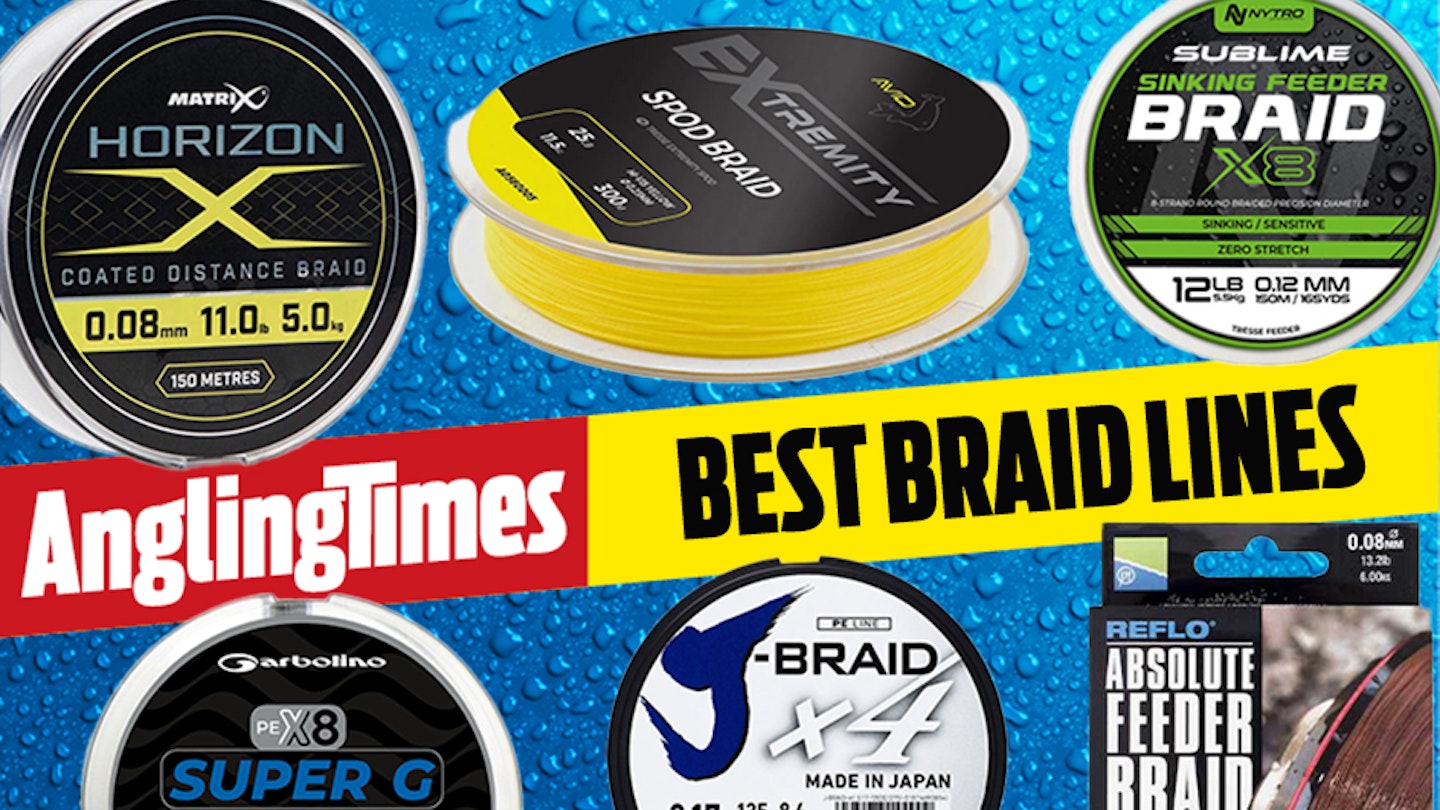Braided mainlines have a lot of advantages over standard monofilament lines, especially when it comes to bite detection. Braid has zero stretch, so whatever happens at the hook end is transmitted directly to the rod tip, it also helps feeling the lead down to help you understand what the bottom of the lake is made up of. A good braid is also more abrasion resistant than mono and is far less susceptible to being broken down by UV light, so it will last far longer on your spool before it needs changing.
Braid is generally a little trickier to use than a monofilament equivalent, its thinner diameter and lighter profile mean it is very prone to wind knots and crack offs, especially when it is new. You will also find it doesn't sink anywhere near as quickly, or as well, which can be problematic in windy situations. However, as long you load your spool a little lower than normal and thoroughly wet the braid before casting, you shouldn’t experience too many troubles when fishing with it.
Best fishing braids at a glance...
• Best Braid For Durability - Preston Absolute Braid - View offer on Go Outdoors
• Best Value Braid - Daiwa X4 J-Braid - View offer on Total Fishing Tackle
• Best Spod Braid - Gardner Kinetic Spod Braid - View offer on Total Fishing Tackle
• Best All-Round Braid - GURU Pulse8 Braid - View offer on Total Fishing Tackle
When bites are at a premium or when feeder fishing for shy biting fish, braid is definitely the best option to make sure you are aware of everything going on in your swim. There are loads of great braids out there, so our list is by no means exhaustive. We have chosen mainly eight-strand braids, which give a rounder profile and smoother cast. That said, there are some good four-strand braids on the market, should you be shopping on a budget. Here is a guide to some of the best available...
Best braid for durability
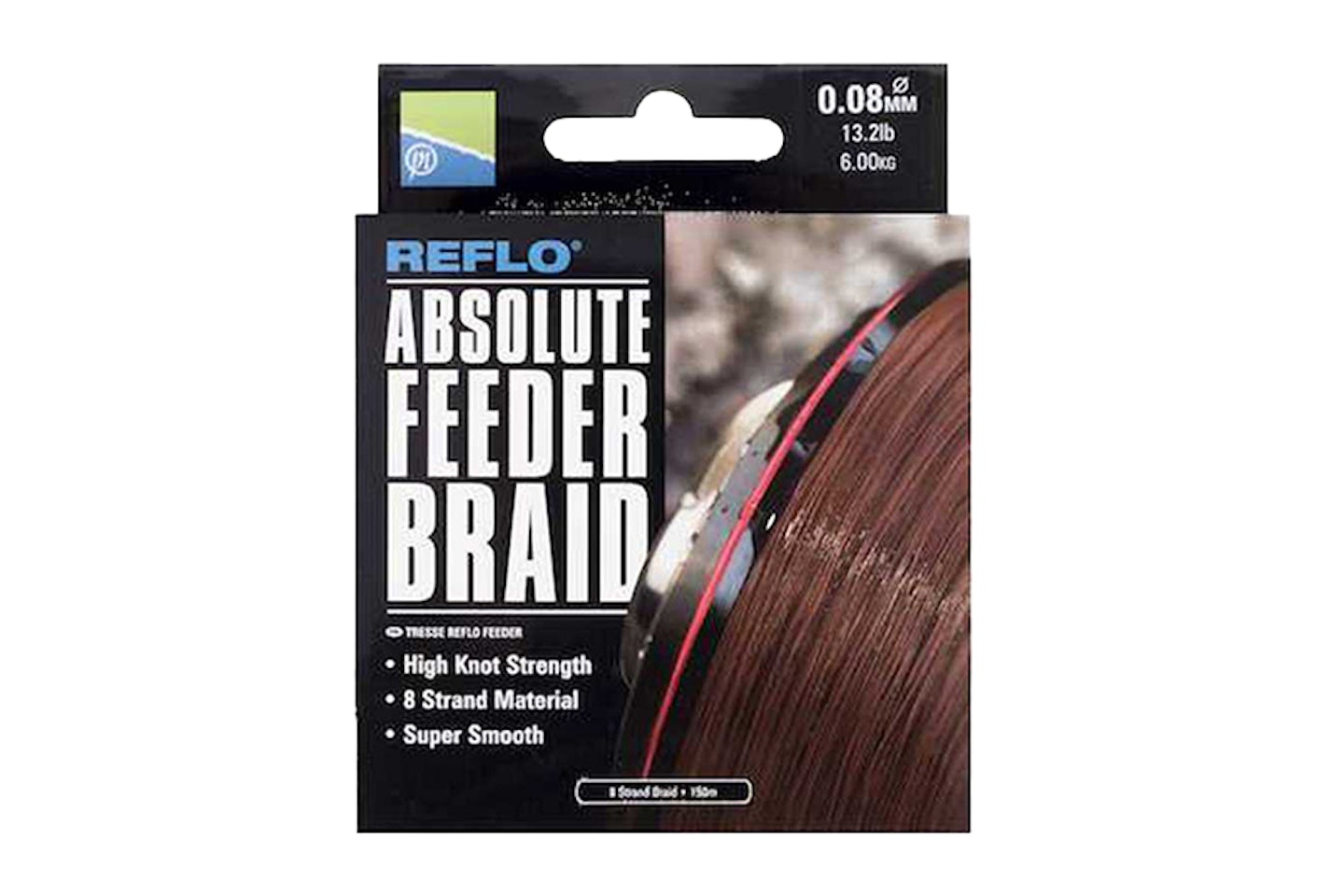
www.gooutdoors.co.uk
The eight-strand PE material Preston Absolute Braid is a strong, durable and smooth braid. A coating has been applied during manufacture, which really helps it cut through surface tension, especially on flat calm days, and gives it a unique red colour.
Comes on 150m spools in 0.08mm, 0.10mm and 0.12mm, all with breaking strains above 13lb.
This braid is hard-wearing, with top sinking properties, but the red coating does end up on your guides and reel rollers.
Pros
- Incredibly good casting performance.
- Unique colouration.
Cons
- The thinner diameter can be prone to wind knots, make sure it is well wetted before using.
Best sinking braid

www.total-fishing-tackle.com
Nytro Sublime X8 Skinking Feeder Braid is a high-quality, eight-strand, fast-sinking braid, and is specifically designed for feeder fishing. Featuring a sinking core, it has zero stretch, a round profile, a smooth surface and high tensile strength. Available in 0.08mm, 0.10mm and 0.12mm on 150m spools.
A brand new braid to the market, boasting a PTFE core, making it heavier than water and allowing it to sink exceptionally well.
Pros
- Sinks really well for a braid.
- The coating makes it very robust.
Cons
- The coating makes the braid a little stiff, which will reduce distance.
Best all-round braid

www.total-fishing-tackle.com
Guru Pulse 8 Braid is a strong and smooth eight-strand braid with a very rounded profile, it casts very well. Extremely strong and low diameter, the 0.08mm breaks at 15lb, 0.10mm at 18lb and 0.12mm at 24lb. The 150m spools ensure there’s enough for all feeder fishing needs.
A good sinker in normal conditions, although it does need a little persuasion when the lake is flat calm.
Pros
- Fantastic for casting.
- Very strong.
Cons
- Not the best sinking braid available.
Best braid for beginners
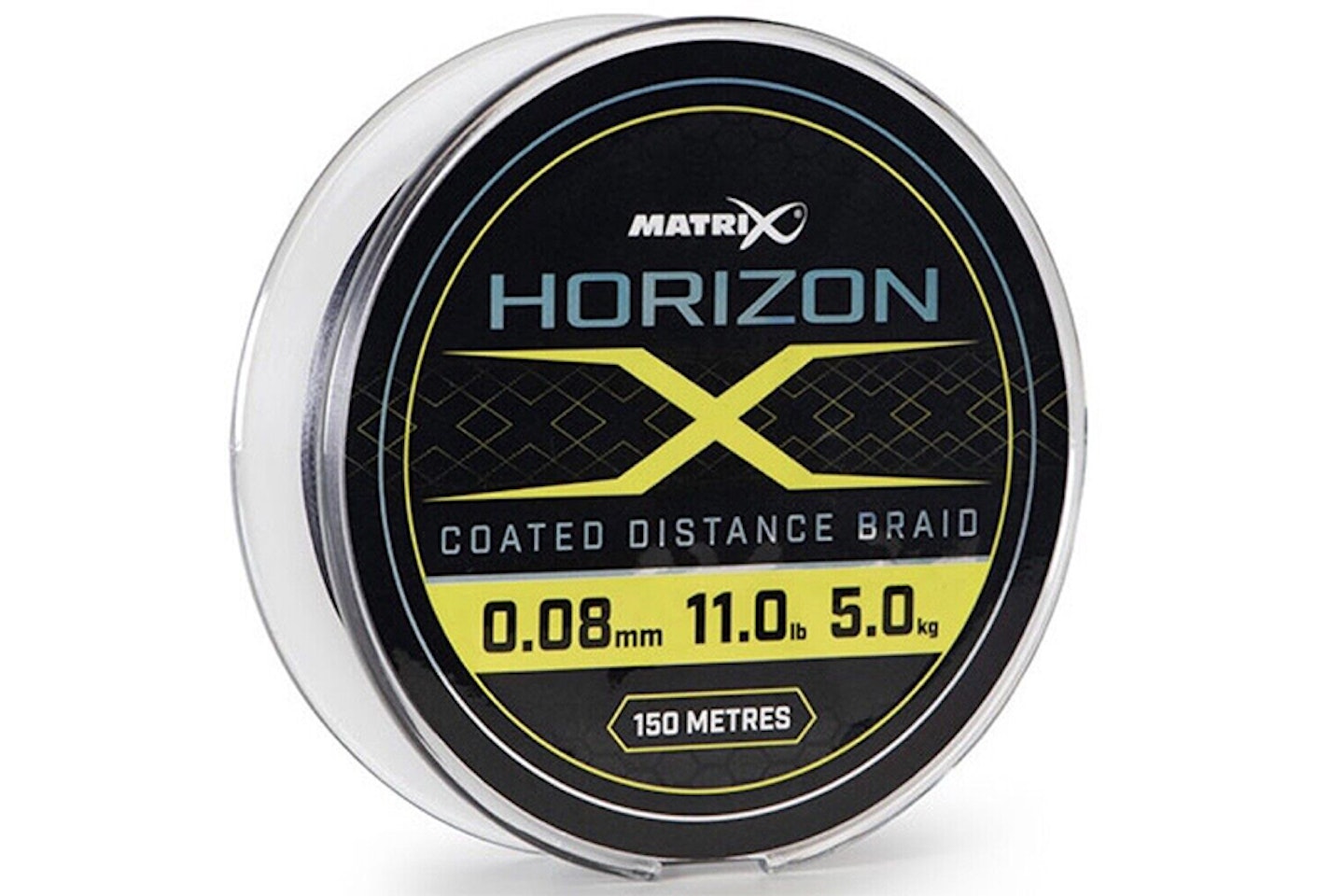
www.ebay.co.uk
From the maker of Submerge – the first high-tech, eight-strand feeder braid – comes Matrix Horizon X Coated Distance Braid, which has a coating that makes it smoother, better sinking and slightly stiffer to prevent wind knots. Comes in three sizes on 150m spools.
It might not be as strong as some other braids (11lb at 0.08mm), but its tangle-free, smooth casting nature makes it a strong contender.
Pros
- Sinks well.
- Smooth performance.
Cons
- The coating does slightly reduce the casting distances.
Best value fishing braid
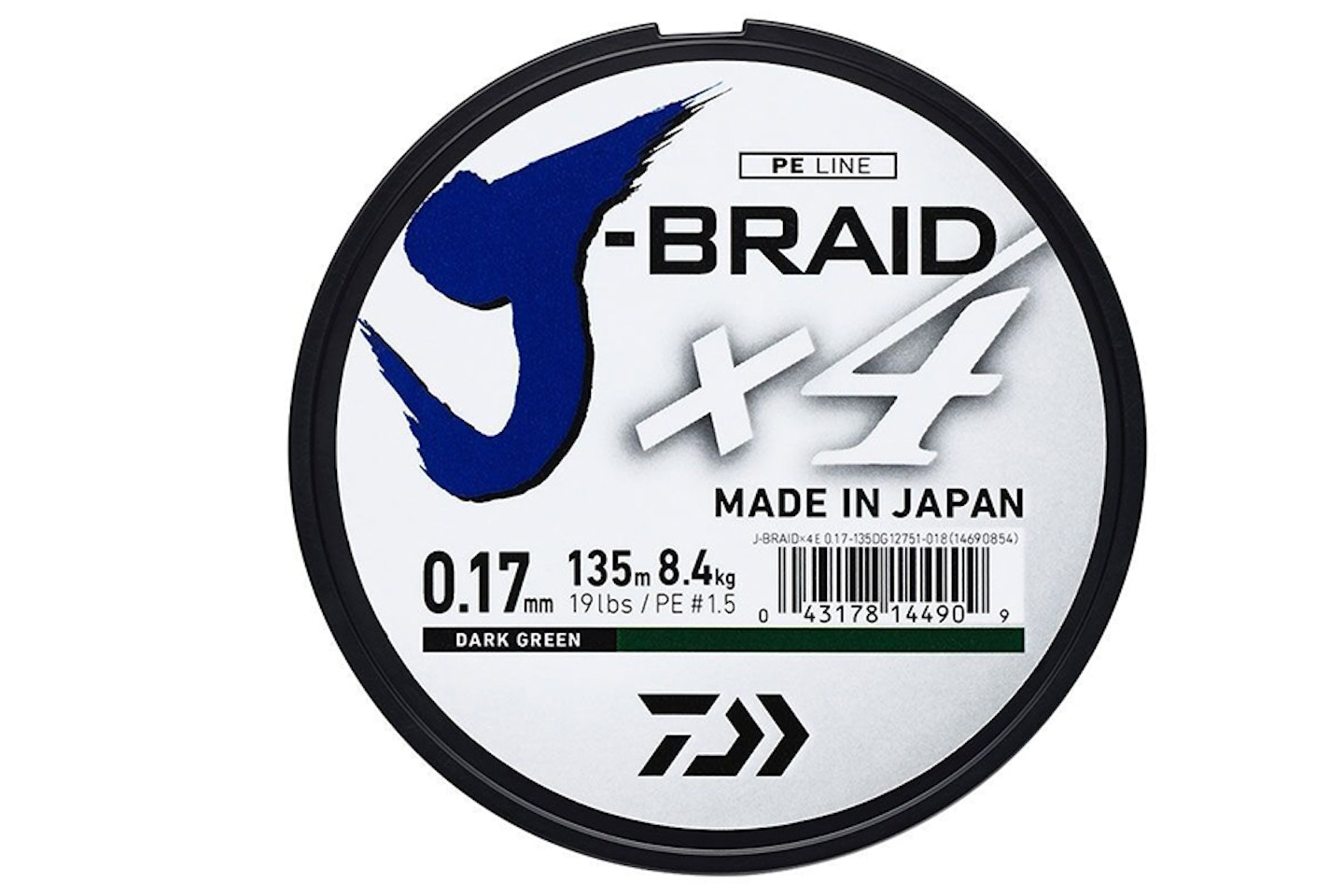
www.total-fishing-tackle.com
A high-tech Japanese-made braid primarily designed for sea and lure anglers, Daiwa X4 J-Braid is now finding favour with feeder anglers looking for cheaper alternatives to premium variety lines. The lowest 0.13mm, 13lb breaking strain is best suited to feeder fishing and is available on 135m and 270m spools.
An unusual braid in that it’s only four strand, yet retains a reasonably round profile. A smooth and functional budget
braid at near half the price of eight-strand.
Pros
- Great value.
- Ideal for a wide range of fishing scenarios.
Cons
- The 4-strand does make it lighter and prone to knotting.
Best casting braid

www.ebay.co.uk
This high quality Garbolino Super G Feeder Braid is an olive green eight-strand braid and is super-smooth, creating hardly any noise on the cast or retrieve and, more importantly, it adds distance and accuracy to long chucks. Supple and thin, it comes on 150m spools and in 0.08mm, 0.10mm and 0.12mm diameters.
One of the smoothest braids on the market, which is a massive benefit when distance casting, but this can cause issues for inexperienced anglers in windy weather, when it pours off the spool exceptionally freely.
Pros
- Great for casting a long distance.
- Incredibly smooth and thin braid.
Cons
- Can tangle on the reel due to how easy it comes off.
Best braid for big fish
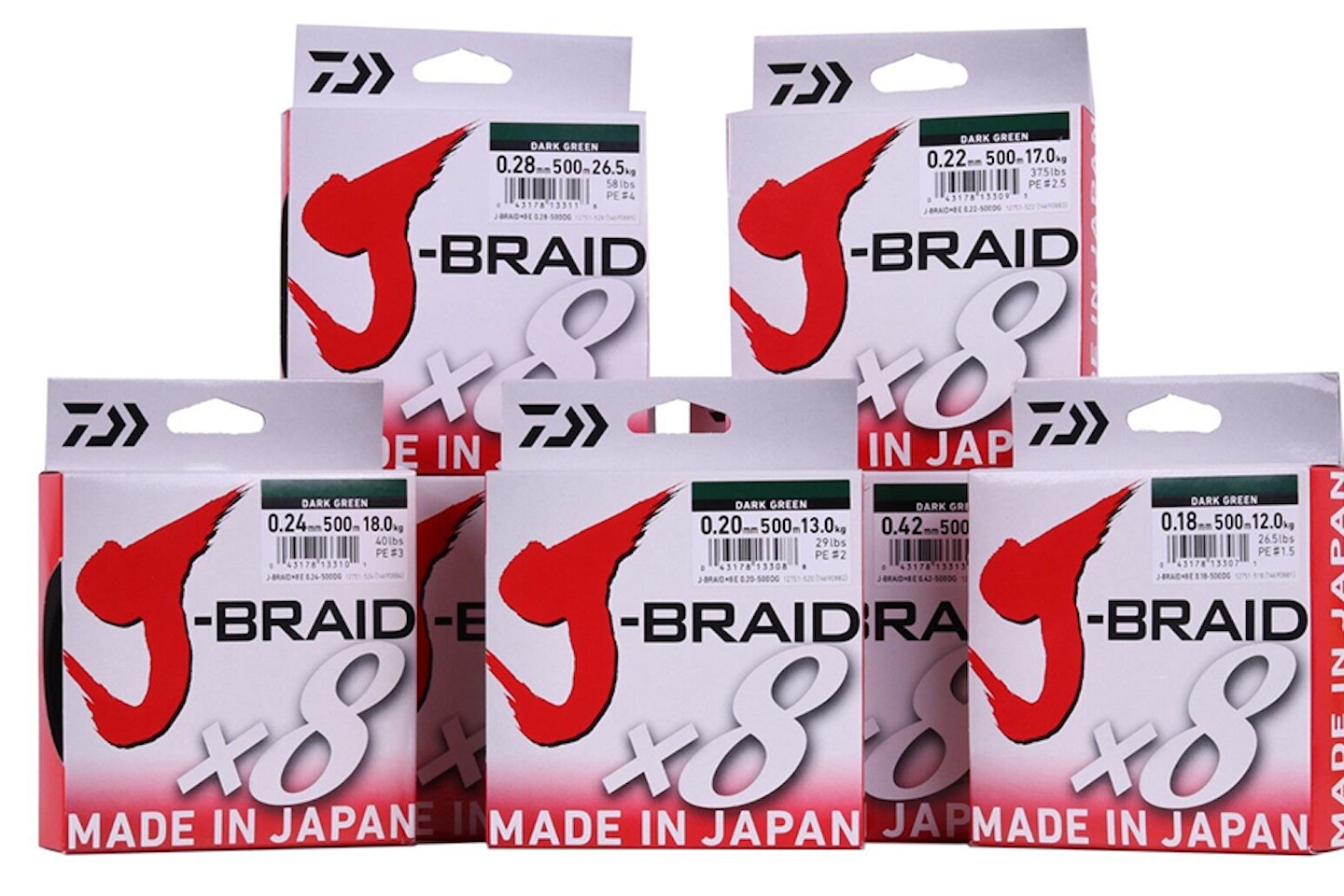
www.total-fishing-tackle.com
A high-quality Japanese line, Daiwa J-Braid X8 is very affordably priced and with uses as diverse as light lure fishing and deep-sea jigging. Available from 26lb to a whopping 103lb breaking strain.
Comes on 500m spools but, if you’re lucky, you might find the now discontinued 1,500m spools still in stock in some shops.
Pros
- Super strong.
- Very reliable braid.
Cons
- It's not the thinnest braid available.
Best long distance braid
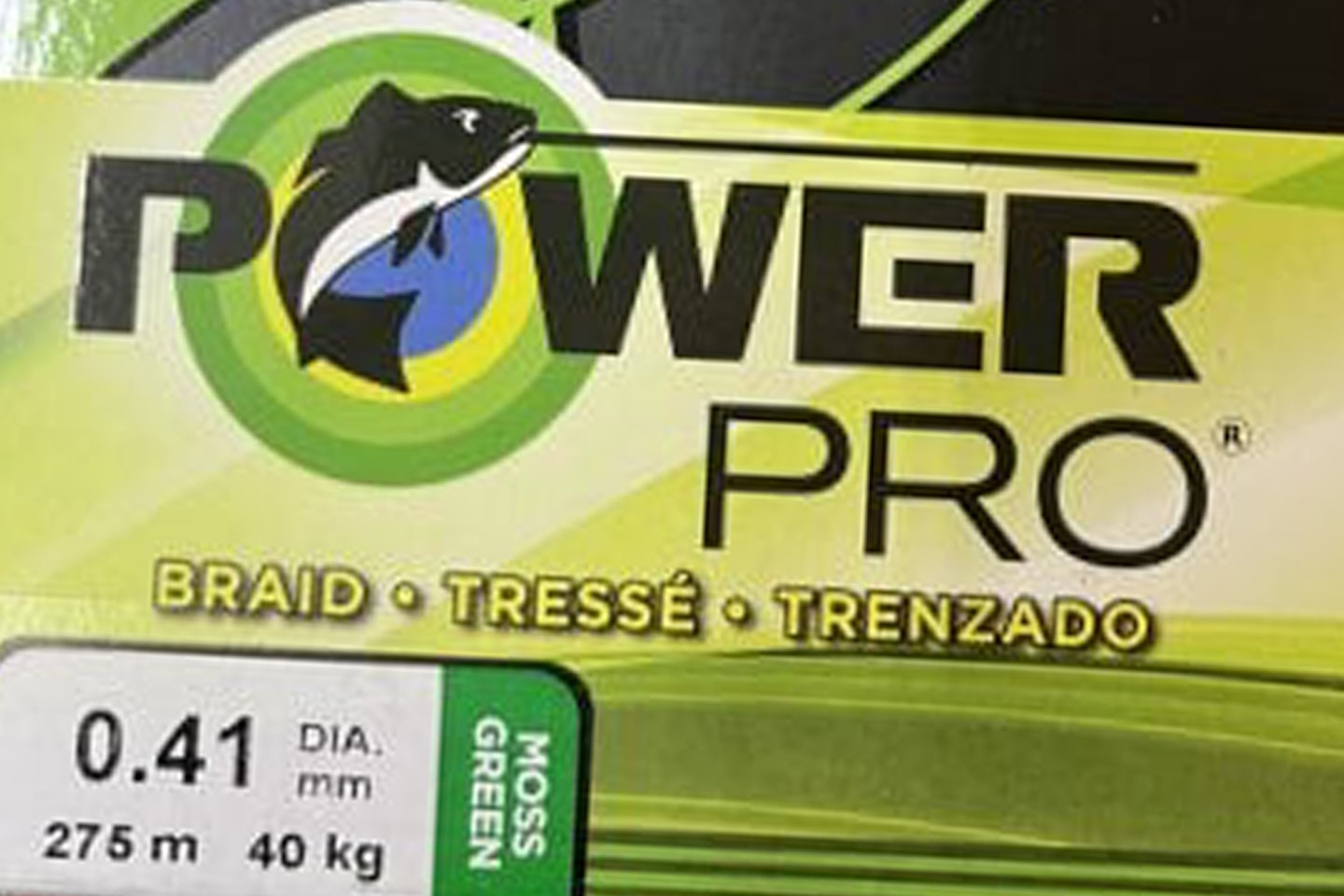
www.northeasttackle.co.uk
Very thin, with superb abrasion resistance, Power Pro Moss Green Downrigger is a discreet weedy green-coloured braid, made in the USA. Available in nine strengths from 0.15mm/20lb through to 0.46mm/121lb.
A highly rated braid suited to big game fish and carp. Available on 135m, 275m, 455m, 1,370m and mammoth 2,740m spools.
Pros
- Great for towing out at long range.
- Superior strength, perfect for all specimen fish.
Cons
- Isn't the smoothest, not the best for casting.
Best spod braid

www.total-fishing-tackle.com
The Gardner Kinetic Spod Braid is now thinner at 0.30mm and rated at a true knot strength breaking strain of 35lb, meaning it can be used without a shockleader. You get 250m of this low-viz dark green eight-strand braid on a spool.
Due to the way the breaking strain is measured, this braid is stronger than you’d expect. Being shockleader-free and affordably priced makes this a very cost-effective spodding braid.
Pros
- Very strong braid.
- Doesn't require a shockleader.
Cons
- Would benefit being brighter in colour.
Best marker braid
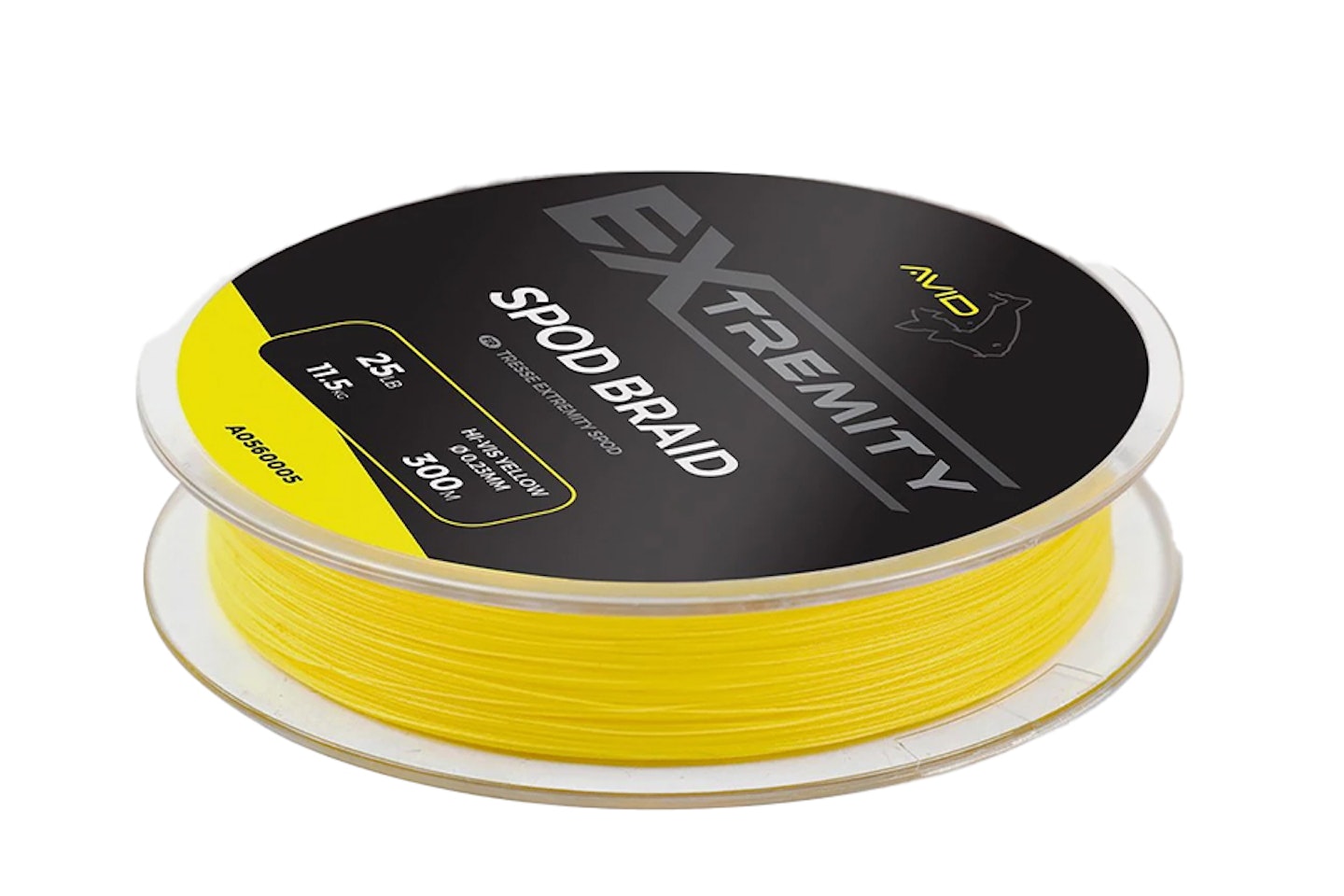
www.fishingrepublic.co.uk
Designed for casting spods and Spombs extreme distances, this low-diameter and super smooth Avid Extremity Spod Braid has a high knot strength. Hard-wearing and strong, you get 300m of this 0.23mm 25lb braid on a spool.
Being brightly coloured can be an advantage with a spod braid, not just so the angler can see where it’s going, but it can stop gulls and diving birds going after your sinking payload.
Pros
- Brightly coloured aiding accuracy and deterring birdlife.
- Smooth finish to help distance casting.
Cons
- Not very suitable for using on your fishing reels.
Best bait-up fishing braid
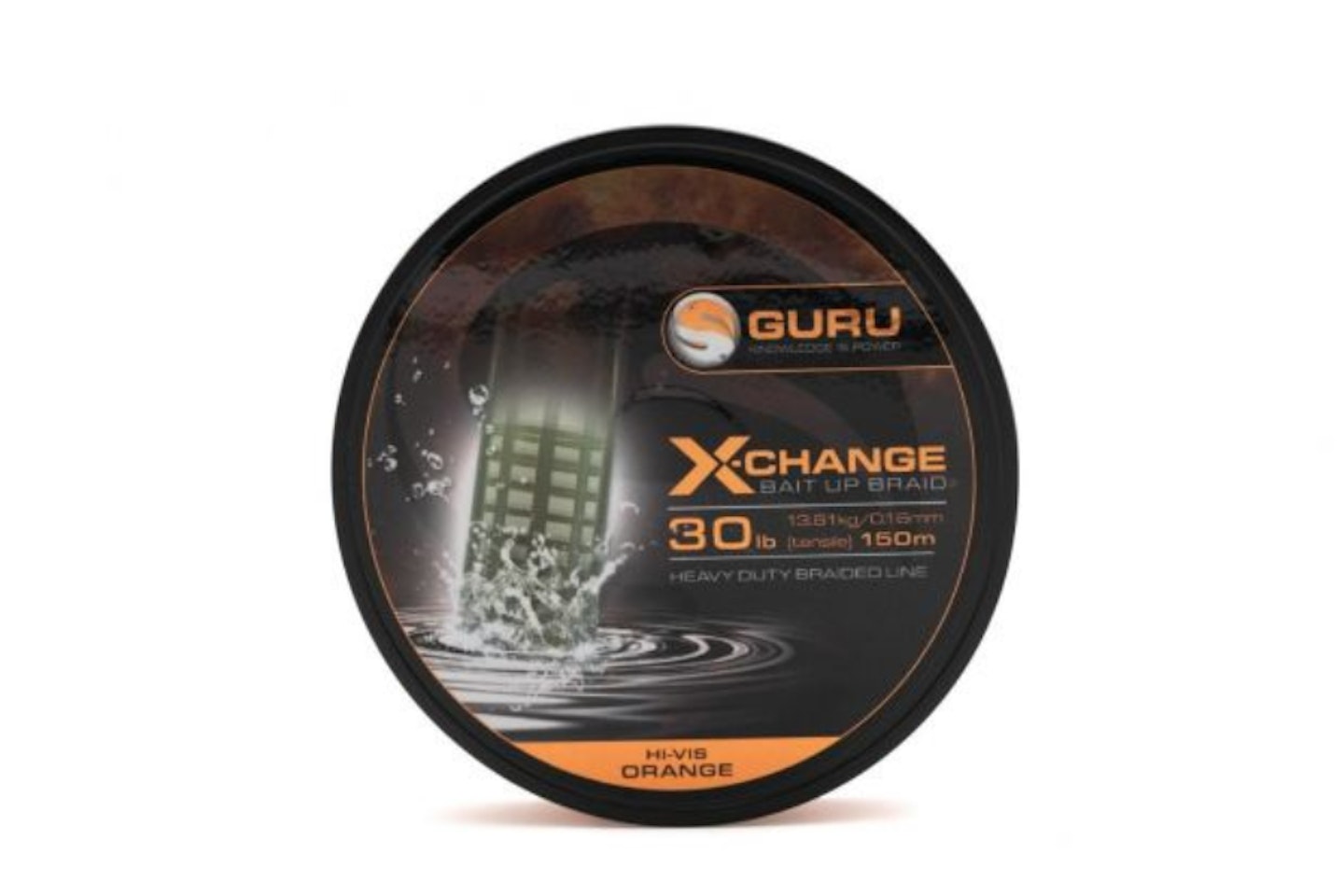
www.total-fishing-tackle.com
Specifically designed for the challenging task of baiting a swim with heavy feeders. The Guru X-Change Bait Up Braid is vibrant Hi-Viz orange colour that makes it visible during casting and retrieval, ensuring precision when feeding at a distance. Crafted to endure the constant pressure of launching loaded bait-up feeders, this braid provides exceptional durability and abrasion resistance, minimising the chances of premature wear or breakage.
With an impressive 30lb breaking strain, the braid maintains a slim diameter of 0.16mm, enabling smooth, long-range casting with minimal drag. This design enhances accuracy when feeding a swim, helping you build a swim effectively. Available in 150m spools, the X-Change Bait Up Braid is a dependable option for your bait-up set up.
Pros
- Low diameter for breaking strain (0.16mm/30lb)
- Hi-Viz colour for visibility
Cons
- Need thorough lubrication to avoid wind knots and wear
What to look for in a fishing braid
When choosing a braid for fishing, the best decision will always be based on what style of angling you do and what you will demand from the braid. All braids have slightly different characteristics, some are made to cast long distances, others are designed to be robust and strong, or made as thin as possible to reduce drag. It is important you choose the right characteristics, as the wrong choice will make using the braid almost unbearable.
If you're looking to cast a long way, it is best to opt for an 8-strand braid with a low diameter. The extra strands make the profile rounder and smoother, allowing it to come off the spool easier, whilst the thinner diameter reduces drag when it is flying through the air. Some braids also come with a PTFE coating, which can help with the smoothness but also stiffen the braid slightly to reduce wind knots, which can be a problem when long casts are necessary.
Similarly, if you're carp fishing and using a boat to tow rigs a long way out into the lake, a thinner braid would be an advantage, as it is far less likely to pick up debris floating around in the lake and it will also reduce the drag caused by undertow, which could potentially move your rig out of position. However, If you're pike fishing it is best to opt for a much stronger and more robust braid. Generally, the casting isn't as important but you must ensure you don't snap off when a pike takes the bait, it allows you to retrieve a rig if it becomes snagged too, as you can bend the trebles out.
Glossary
Diameter: The distance across a circle, which equates to how thick a line is. The higher the diameter the thicker the line will be.
Breaking strain: The amount of pressure that must be applied to an unknotted line before the line breaks. Therefore it doesn't mean you can only catch fish upto 10lb on 10lb line.
Abrasion resistance: The ability of a surface to resist being worn away by rubbing or friction, the better the resistance, the more it will resist being worn away.
High stretch: The amount a line will stretch varies amongst monofilaments, a higher stretch line will just simply stretch further at a given length then a low stretch.
Supple: How easily something bends and moves, the more supple, the more freely an object will move.
Spool: A cylindrical device upon which the line is wound.
8-strand: This refers to the amount of fibres in each length of braid. 8-strand has 8 individual fibres braided together to make the finished braided line. Similarly 6-strand has 6 etc.
High knot strength: The ability to maintain strength as close to the original breaking strain after knotting the line.
Monofilament line: Monofilament fishing line (shortened to just mono) is fishing line made from a single fiber of plastic material.
Braided line: Braids are made by braiding or weaving fibers of a man-made material into a strand of line. The strand number will indicate how many fibres are woven together.
Shockleader: A length of heavier breaking strain line that is attached to your main fishing line so that it does not break during the cast.
Crack-off: The name given to the line breaking during a cast, often caused by knot or the line wrapping around an eye on the rod.
<strong>Frequently asked questions on braided line</strong>
Will diameter affect the distance I can cast?
The higher the diameter, the thicker the line, the more friction it will produce through the rod rings when it is cast. If you are looking for extreme distances, using a lighter line with a shock leader will help. We would advise though, if the fish are simply too far, do not use a line that will not be up to landing the fish, just so you can reach them. As all breakages that can be avoided should be.
What breaking strain braid should I use for pike fishing?
If you're using a deadbait, we strongly recommend you use a minimum of 30lb breaking strain, this will ensure your tackle is robust enough that you don't snap off when you hook a pike. A 50lb braid is even better, as it allows you to bend the hooks out if you get snagged, so you don't leave a live rig in the water that could cause a pike to become tethered.
Do I need a shock leader when using braid?
It is always beneficial to use a shock leader when using a braided mainline. A monofilament shock leader helps cushion the cast thanks to its stretching properties and it helps cushion the fight when a fish is hooked to prevent hookpulls. Without a shock leader, casting a heavy lead or feeder on braid that has no stretch is a recipe for crack-offs and broken rod tips.
{#block-f8566fc2-8446-4657-91be-9c046055b640}
Author Dan Webb first became involved in angling journalism in 2015 and has worked as Tackle Tester at Angling Times since April 2021. He is a fanatical all-round match angler and former England Youth International.
